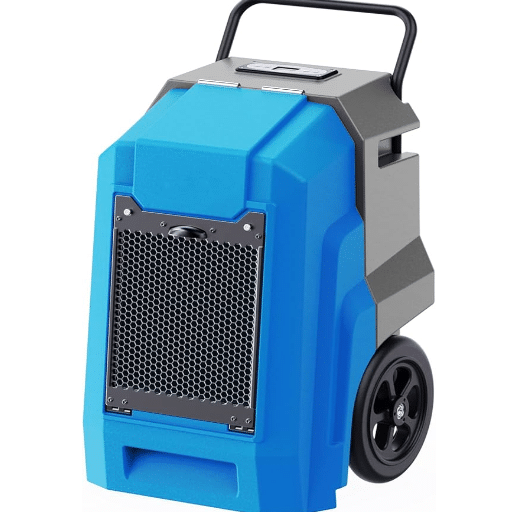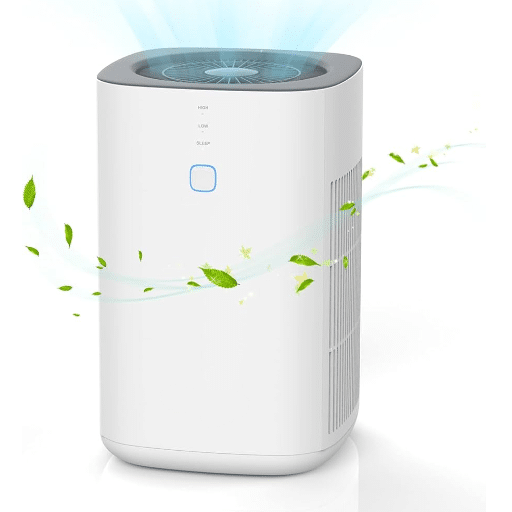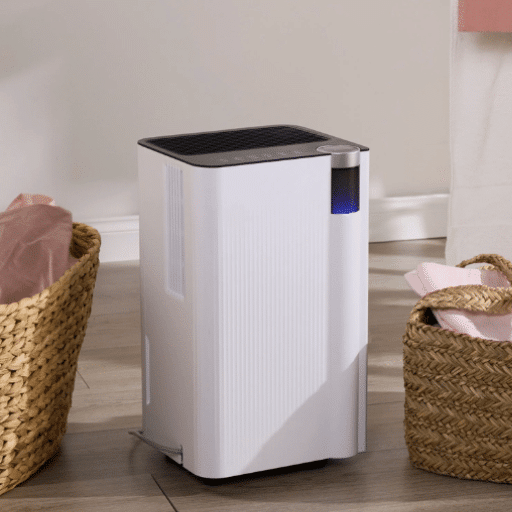Keeping humidity levels in your home at the right spot is very important for comfort and health. On the one hand, dampness in the air can support the growth of mold, dust mites, and other allergens while on the other hand, very dry air can cause respiratory problems and damage to the structure of your house. Knowing how to set and control your dehumidifier at home correctly is the main secret to getting a balanced indoor atmosphere.
This article will delve into science regarding ideal humidity levels, the significance of precise settings, and practical advice to maximize the efficiency of your dehumidifier. At the end, you will have the ability to build a healthier and more comfortable habitat that is exactly how you want it.
Understanding Humidity and Dehumidifiers

Humidity is the term used for the amount of water vapor present in the air, and the maintenance of appropriate humidity levels plays a significant role in determining both comfort and health. Usually, the ideal indoor humidity range is considered to be somewhere between 30% and 50%.
An appliance for reducing humidity or a dehumidifier removes moisture from the air, thereby preventing the occurrence of problems like mold development, unpleasant smells, and damage to walls or furniture due to high humidity.
In order to maximize the effectiveness of a dehumidifier it is advisable to set it up in an airflow area, adjust the setting to the required humidity level—usually 40% for health and comfort—and make sure to empty the tank of water frequently or use the continuous draining feature if it has one.
What is Humidity?
Humidity is the amount of water vapor in the air, which is a significant factor in both nature and mankind. It can be quantified scientifically as:
- Absolute Humidity: Indicates the total amount of water vapor in the air and is expressed in grams per cubic meter
- Relative Humidity: Shows the amount of moisture in the air as a percentage of the maximum amount it can hold at that temperature (most commonly used measure)
- Specific Humidity: The ratio of water vapor mass to the total mass of moist air
In summer months, high humidity makes people feel hot because sweat cannot evaporate off the skin, while in winter months, low humidity can result in dry skin, breathing problems, and material degradation. Humidity is also a key factor for agriculture, manufacturing, and data centers where ideal conditions are prerequisites for maximum functioning.
How Dehumidifiers Work
Dehumidifiers serve the purpose of removing moisture from the atmosphere to keep air at its perfect humidity level. The most popular type uses refrigeration technology:
- Air Intake: A fan pulls humid air into the appliance
- Cooling Process: Air passes through cold coils and gets cooled down
- Condensation: When air cools to its dew point, water vapor turns to liquid
- Water Collection: Liquid is stored in a tank or drained through a tube
- Air Release: Drier, warmed air is released back to the surroundings
Top-class models feature desiccant technology using moisture-absorbing substances without refrigerants. Energy-efficient dehumidifiers with smart controls including humidity sensors and Wi-Fi connectivity for remote monitoring are becoming increasingly popular.
Importance of Maintaining Optimal Humidity
A proper level of humidity has a huge positive effect on the health of people and the longevity of property. Current trends show a sharp increase in searches about indoor humidity control.
| Humidity Level | Conditions | Problems |
|---|---|---|
| Above 60% | Too Humid | Mold growth, dust mites, allergens, respiratory problems (asthma, allergies) |
| 30-50% | Optimal Range | No issues – ideal for health and property preservation |
| Below 30% | Too Dry | Dry skin, irritated eyes, degradation of wood furniture/flooring |
Determining the Best Humidity Setting for Your Dehumidifier
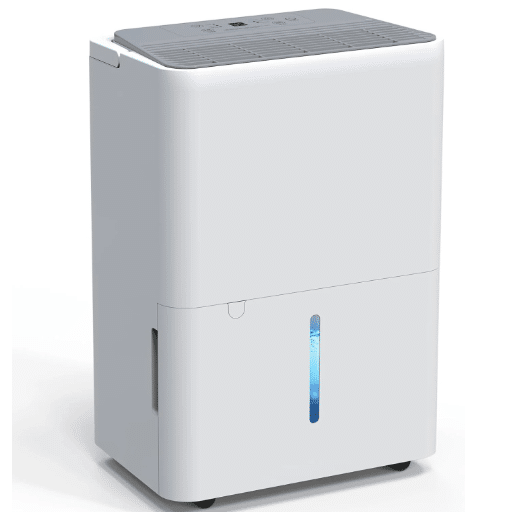
The optimal humidity level for your dehumidifier is a decision that has to factor in several different variables: current climate conditions, the particular living area in your house, and the health conditions of the people living there, among others.
Studies and surveys suggest that the best indoor humidity is in the range of 30% to 50%. This range ensures the air contains the right amount of moisture—not too dry to irritate respiratory systems and skin, yet not too wet to cause mold growth or building damage.
Factors Influencing Humidity Levels
Indoor humidity levels are influenced by several key factors:
- Temperature: Warmer air can hold more moisture, implying humidity can rise in summer or poorly ventilated spaces. Heating systems in cold months draw moisture from air, creating dry environments
- Ventilation: Lack of air movement prevents natural moisture removal, creating higher humidity in kitchens and bathrooms where moisture is generated
- Building Materials: Wood becomes waterlogged if humidity isn’t controlled, while other materials like paint may be less affected
- Insulation Quality: Determines whether moisture is absorbed or retained
- External Conditions: Rain, geographic location, and seasonal variations impact indoor humidity—rainy areas are naturally humid while deserts are dry
Suggested solutions involve utilizing dehumidifiers strategically, sealing holes and cracks to prevent water entrance, and providing sufficient cross-ventilation to maintain indoor humidity in the optimal 30-50% range.
Recommended Humidity Levels for Different Areas
| Space Type | Recommended Humidity | Reason |
|---|---|---|
| Residential Areas (General) | 30-50% RH | Prevents mold growth, condensation, and allergen proliferation |
| Basements & Storage Spaces | 30-40% RH | More prone to moisture problems; lower range recommended |
| Offices & Workplaces | 40-50% RH | Comfortable environment free from static electricity; aids concentration |
| Healthcare Settings (Hospitals) | 40-60% RH | Prevents spread of airborne pathogens while ensuring patient comfort |
Setting Your Dehumidifier for Indoor Humidity
Getting the most out of your dehumidifier’s settings means knowing the standards and environmental needs of the moment:
| Season/Condition | Recommended Setting | Purpose |
|---|---|---|
| Winter | 30-40% RH | Prevents condensation on windows and mold spread |
| Summer / Humid Regions | Close to 50% RH | Beneficial for human health and air quality; decreases dust mites and allergens |
- Use built-in hygrometers to track room humidity in real-time
- Place dehumidifier in moisture-prone rooms (basements, bathrooms)
- Consider smart home technology integration for accurate humidity management
Using a Dehumidifier in Your Basement
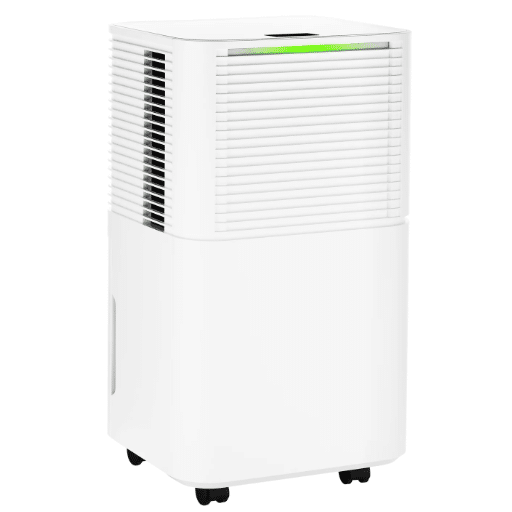
Basements are, in a way, the most affected by high humidity because they are placed underground where moisture can easily penetrate through walls and floors. A dehumidifier in your basement is a must if you want to keep the humidity levels right.
Why Basements are Prone to High Humidity
Basements are the areas of a house where moisture is most likely due to several environmental and structural factors:
- Below-Ground Position: Constant contact with soil around them; moisture retained by soil especially during heavy rains or in areas with high groundwater
- Limited Ventilation: Very limited compared to above-ground spaces, which hinders air circulation and traps humidity
- Temperature Differential: Warm air enters basement, cools and condenses, increasing moisture
- Porous Building Materials: Concrete and masonry absorb and retain moisture
- Seepage Issues: Moisture transfer through basement walls and floors from surrounding soil
Searches for “humidity in basements” and “moisture problems in basements” increase significantly during humid climates, especially spring and summer, indicating widespread homeowner concerns about condensation and moisture issues.
Ideal Dehumidifier Settings for Basements
Setting the dehumidifier to the right humidity level is critical to keeping the basement in ideal condition and preventing problems related to excess moisture.
Target Range: 30-50% Relative Humidity (RH)
- Lower End (30%): May create discomfort or damage some materials if maintained long-term
- Higher End (50%): Prevents excessive dryness while still inhibiting mold proliferation
- Sweet Spot (40%): Ideal balance for most basement environments
Modern Dehumidifier Features for Basements:
- Built-in Hygrometers: Monitor RH levels accurately
- Automatic Humidity Control: Maintains set levels without manual adjustment
- Energy Efficiency Ratings: Ensures consistent performance with lower power consumption
- Continuous Operation Mode: For high atmospheric humidity areas
Periodic cleaning and maintenance—including draining the water tank and replacing filters—contributes to the device’s overall effectiveness and longevity.
Ventilation Tips for Basement Humidity Control
Proper ventilation is a key factor in fighting basement humidity by regulating air circulation, preventing condensation, and stopping moisture buildup that allows mold growth and structural damage.
Recommended Ventilation Strategies:
- Install Exhaust Fans: Use ducted ventilation systems for constant air circulation
- Mechanical Ventilation: Exhaust systems with integrated humidity sensors that automatically switch on/off based on moisture levels
- Natural Cross-Ventilation: Place vents at the most distant points of basement for uniform airflow distribution
- Seal Foundation Issues: Seal gaps, cracks, and leaks before installing ventilation systems
- Combine with Dehumidifier: Ventilation plus reliable dehumidifier creates powerful barrier against humidity
Monitoring and Adjusting Humidity Levels
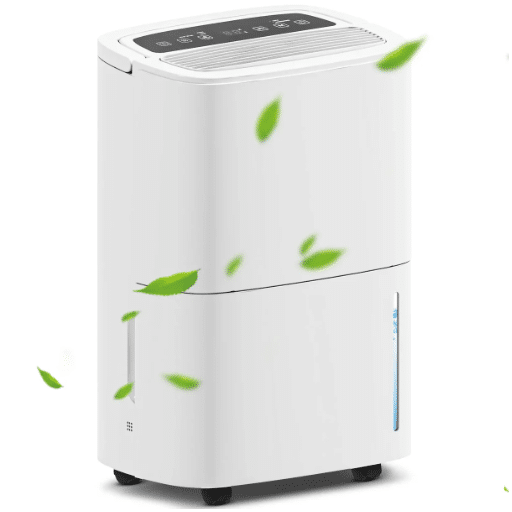
The importance of monitoring indoor humidity levels is critical for maintaining the proper environment, because changes in humidity can lead to building destruction as well as health problems.
The perfect indoor relative humidity should be maintained at between 30% and 50%, because levels beyond this range will cause and spread mold, affect dust mite presence, and lead to respiratory issues.
How to Measure Indoor Humidity
The accurate measurement of indoor humidity involves the hygrometer, a device specifically designed for this purpose:
| Device Type | Features | Best Use |
|---|---|---|
| Digital Hygrometers | Exact readings, show temperature and relative humidity percentage | General home use; place in central area away from air currents, sunlight, or heat sources |
| Smart Thermostats | Include humidity sensors, real-time monitoring, mobile app control | Whole-home monitoring with historical data tracking and trend analysis |
| Professional Tools | Calibrated devices with high accuracy | Periodic verification and precise measurements |
Measurement Best Practices:
- Place hygrometer in central location away from direct influences
- Avoid positioning near windows, doors, vents, or heating/cooling sources
- Allow device to stabilize for accurate readings (15-30 minutes)
- Take multiple readings throughout the day for comprehensive understanding
- Calibrate devices periodically for ongoing accuracy
When to Change the Humidity Setting
Adjusting the humidity setting depends on various dynamic factors such as seasonal changes, geographical areas, and the indoor climate itself.
| Situation | Recommended Action | Reason |
|---|---|---|
| Winter in Cold Areas | Set to lower end (30-35% RH) | Avoid condensation and mold growth |
| Hot/Humid Periods | Use dehumidifiers/AC to maintain upper level (45-50% RH) | Prevent dust mites and mildew |
| Health Problems Present | Adjust to comfort level within 30-50% range | Respiratory comfort and allergy management |
| Wooden Floors/Instruments | Maintain steady 40-45% RH | Prevent warping, cracking, or damage |
Smart humidity control systems with sensors offer real-time monitoring and alerts, allowing for precise adjustments within the recommended range. By analyzing environmental data with advanced tools, you can ensure optimal breathing conditions, property protection, and overall comfort.
Signs of Poor Indoor Air Quality
Indoor air quality (IAQ) that is poor can show itself through various physical, environmental, and health-related signs:
- Persistent Odors: Mold or chemical odors indicating pollutant presence
- Allergy-Like Symptoms: Coughing, sneezing, itchy eyes, respiratory discomfort from dust, pet dander, or VOCs
- High Humidity Effects: Mold growth, condensation on windows
- Health Complaints: Headaches, tiredness, slight nausea among occupants (may indicate carbon monoxide, radon, or poor ventilation)
- Visible Mold/Mildew: Growth on walls, ceilings, or other surfaces
- Musty Smell: Indicates moisture problems and potential hidden mold
Utilizing skilled IAQ monitoring and air handling systems, measures can be designed to address and lessen these vital problems, thus providing a healthier setting.
Preventing Water Damage and Maintaining Indoor Air Quality
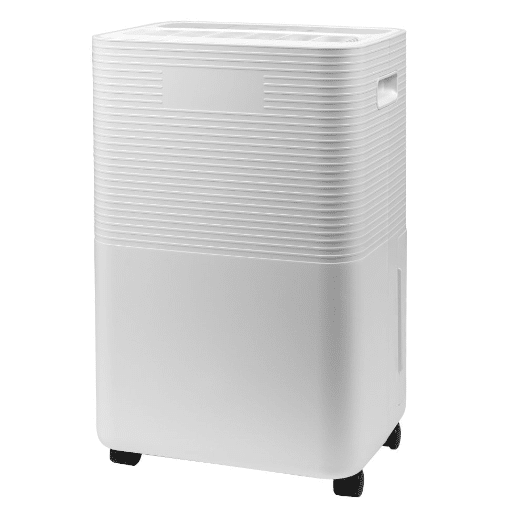
It is impossible to completely eliminate water damage and consequent poor indoor air quality (IAQ) risks, since they are interwoven—excess moisture leads to deteriorating IAQ. Excess moisture and water intrusion are significant contributors to mold and mildew growth, thus worsening IAQ.
Common Causes of Water Damage
| Cause | Description | Impact |
|---|---|---|
| Leaking Pipes | Corrosion, excessive water pressure, or damaged seals | Often unnoticed until significant damage occurs |
| Roof Damage | Missing/damaged shingles, blocked drainage, aged roofing | Water leaks during rains or snow melting |
| Faulty Appliances | Dishwashers, washing machines, water heaters with worn hoses | Leading cause of water-related incidents in homes |
| Poor Drainage Systems | Improper grading, blocked yard drains | Water accumulation near foundation, basement infiltration |
| Natural Disasters | Heavy rains, hurricanes, rising water levels | Large-scale, instant destruction |
Prevention Measures
- Regular Inspections: Check plumbing systems, roofing structures, and foundation seals
- Maintain Humidity: Keep indoor RH at 30-50% using dehumidifiers or high-efficiency HVAC systems
- Install Exhaust Fans: In moisture-prone areas (kitchens, bathrooms) to eliminate humidity
- Smart Technology: Use sensors for leak detection and continuous IAQ monitoring
- Prompt Action: Automated alerts enable quick corrective actions
Using Dehumidifiers to Protect Your Home
Dehumidifiers are essential for keeping indoor air healthy and preventing your house from moisture damage. They lower the humidity level of the air, which prevents mold, fungus, and poor ventilation from occurring.
Data shows searches for “best dehumidifiers for basements” and “mold prevention tips” have increased by more than 40% in the last year, pointing to increasing worry about humidity control among homeowners.
Key Benefits of Dehumidifiers:
- Maintains Optimal Humidity: 30-50% RH as per EPA recommendations
- Prevents Condensation: Reduces conditions for dust mites, bacteria, and molds
- Smart Features: Sensors and connectivity provide accurate control and home system integration
- Energy Efficiency: Modern models promote convenience while reducing power consumption
- Property Protection: Essential for water-prone locations like basements and crawl spaces
Combining Dehumidifiers with HVAC Systems
An HVAC system coupled with a dehumidifier not only guarantees optimal indoor air quality but also improves overall system efficiency.
| Benefit | How It Works | Result |
|---|---|---|
| Reduced Energy Consumption | Dehumidifier reduces moisture load on HVAC during hot season | Less electricity consumption, lower utility bills |
| Improved Comfort | Better temperature and humidity control | Enhanced living conditions year-round |
| Health Benefits | Prevents mold, mildew, and dust mites | Better respiratory health, fewer allergens |
| Extended System Life | Reduces strain on HVAC components | Longer equipment lifespan, fewer repairs |
Recent trends show growing demand for whole-house dehumidifier systems used with central air conditioning. Smart dehumidifiers featuring IoT connectivity are becoming popular for their capability of effortless synchronization with modern HVAC systems. These innovations facilitate simultaneous control of indoor humidity levels and system adjustments, which elongates lifespan while providing uniform indoor atmosphere.
References
-
“Selecting a Dehumidifier” – Provides guidance on selecting and setting dehumidifiers based on capacity, climate, and space size.
-
“Preventing Mold in Your Home” – Recommends keeping indoor humidity between 30% and 50% to prevent mold growth.
-
“Home Moisture 6-05” – Offers insights into energy-efficient dehumidifiers and their impact on home moisture control.
Frequently Asked Questions (FAQ)
What is the perfect humidity range for employing a dehumidifier?
Usual the dehumidifier’s use ideal humidity level ranges from 30% to 50% relative humidity. This range allows you to breathe easier and at the same time it turns to be a must for your home which will avoid problems like mold and water damage.
How to set the dehumidifier for very humid conditions?
Very humid conditions dehumidifier setting is done by changing the humidity setting of the dehumidifier to around 40% to 50%. So, the dehumidifier will be doing its job of taking in moisture and keeping it balanced in your room.
What are the dehumidifier settings for a basement that work best?
For basements, setting at about 30% to 50% relative humidity is considered as the best dehumidifier setting. Preventing the mentioned problems with this humidity level in the basement is crucial due to its moisture issues.
How do I use a dehumidifier to lower the humidity in my house?
The first step to using a dehumidifier to lower the humidity in your house is to identify the current humidity level by means of a hygrometer. After that, set your dehumidifier to the preferred humidity level, usually between 30% and 50%. Make regular checks, and adjust the settings as needed depending on the air’s moisture levels.
Is it a smart move to buy a quality dehumidifier to regulate humidity?
If your dwelling is humid, then buying a dehumidifier is a wise decision. It not only helps to keep the humidity levels at the best, but also contributes greatly to air quality improvement and prevention of mold and water damage issues, thus turning itself to be a very important investment for your house.
Where should I place the dehumidifier?
Ideally, the dehumidifier should be placed in the highest humidity area of the house, like the basement or the laundry room. Furthermore, placing the unit in a well-ventilated area will help it to effectively draw in air and keep the humidity at the desired level.
Mold is one of the problems that dehumidifiers help to avoid by the way, how?
By treating air moisture, dehumidifiers do prevent mold issues and one of their methods is reducing the air humidity. A dehumidifier will be less than 50% maintaining the humidity and hence it’ll be less favorable for the mold spores to grow so your house will be safe from the possible damage.
My dehumidifier has collected more water than expected. What now?
The right humidity setting for your environment should be checked e.g. if too much water is being collected by your dehumidifier. You could use a continuous drainage setup with a drain hose or set the humidity higher to stop overflow. You could also monitor the water collection tank and drain it whenever necessary in order to keep the dehumidifier performing at its best.

